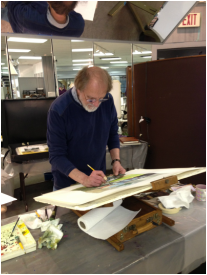 | |
Photo by D. Byron Witt and used with permission.
Bill Vrscak (left) talks to participants at the Morgantown Art Association's spring workshop in April 2013. Photo sourced from Morgantown Art Association's Facebook page: https://www.facebook.com/pages/Morgantown-Art-Association/304517989577522 |
Bill demonstrated each morning, and then we turned to our own boards and attempted to nail his ideas and techniques down with brush and paper. At times I would vaguely feel that I was "getting it" and at other times I flat out didn't, but I never felt extremely frustrated. I could see such value in his ideas and suggestions that I wanted to absorb everything to the fullest extent possible.
I would like to share a detailed record of the workshop, but there is so much that I learned over the course of the four days that I don't know if I can really do justice to the full experience. But I will try.
I'll synthesize Vrscak's philosophy, as I understood it, into one short sentence: The best watercolors do more with less.
That one statement applies to nearly every stage of an individual painting's development. I will try to explain that central idea in a step-by-step way.
 |
| Here is one of Bill Vrscak's sketches as he begins to develop a painting. |
So, Vrscak pares down the subject matter and looks for what he finds vital. And one area in the composition should be of greatest importance -- this is the point of entry for a viewer and everything else is secondary. Sketching helps a painter develop that entry point and then simplify the rest of the scene. As you can see in the photograph of one of his sketches (shown above), there's nothing elaborate about the sketch. It's a road map of sorts -- the relative shapes of the masses have been worked out, there's a hierarchy of dark and light values, and the overall composition within the frame has been established.
 |
| A painting in progress, reflected in the overhead mirror. Here you can see Vrscak's limited palette. |
He said he will mix those up from time to time, substituting Cobalt Blue for Ultramarine, for instance, and maybe he will add some specific color to the palette, such as a earth color, for a particular subject. But for the most part, his large, white palette had mostly empty wells. He said he went to this limited palette some time ago because he wanted to simplify his color mixes and concentrate more on values. The limited palette also makes it easier for him to replicate color mixes, and after years of using it, he knows exactly what ratios of which colors will produce what he needs at a given time with minimal fuss.
 |
| Photo by D. Byron Witt and used with permission. Bill Vrscak Photo sourced from Morgantown Art Association's Facebook page: https://www.facebook.com/pages/Morgantown-Art-Association/304517989577522 |
However, these "one stroke" versions have a much softer feel, more like a nice pointed round. Vrscak said he likes them because of the amount of pigment they can hold. The fewer times he has to go back into his palette to pick up pigment, the better. They also have nice spring and flexibility and can make great "marks." He uses the edges in smaller areas and tries to use as big a brush as he can for as long as he can. He warns that relying on only small brushes leads to excessive concern for the detailed areas, and a loss of vision of the painting as a whole.
He slants his paper as a way of controlling washes and eliminating back runs, and he aways makes subtle changes in the color mixes of the large washes. A good example of this is in the photo above with the distant mountain to the right. A slighter pinker color grades into a greyish green to the right, with a touch of a greyish purple at the base. It's simple, yet so effective. Many more slight color shifts can be seen in the large foreground area. These touches help keep large washes from becoming boring and flat, yet they are subtle and don't distract from the focal point. The overall effect is a feast for the eyes.
Vrscak's goal with the really large areas is to get something down on the first application, make it look interesting, and not go back into it. And that's the secret of "fresh" watercolors. Don't mess with it!
As the painting moves along, smaller brushes are used to develop the important bits of the painting, but only those most important parts get special treatment and more work. Vrscak reiterates that getting too concerned with all the details all over a painting means that you have lost the focus of the painting.
This really was a wonderful workshop for me, and it came at the right time in my development as an artist. I'm beginning to get a sense of what I'm good at doing, and I really enjoy playing with and controlling compositional elements now, so much of what Bill Vrscak offered us in the way of advice and ideas was exceptionally helpful to me. I absolutely would attend another of his workshops and would encourage any watercolorist at any level to take from him as well. He is a great teacher as well as being a great painter, and that is a combination that I really admire.



Thank you, its a nice post! And Bill seems to be know pretty well how it works!
ReplyDelete